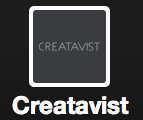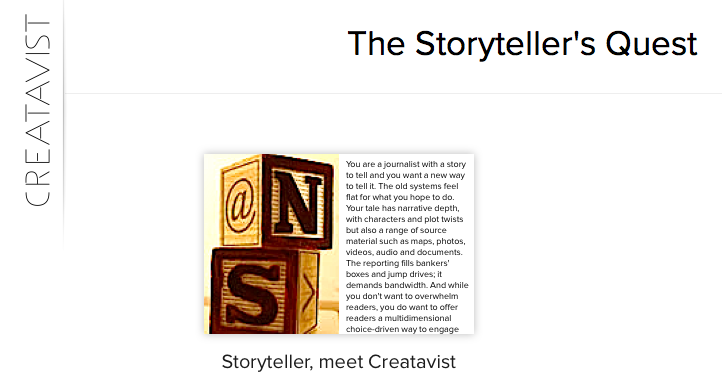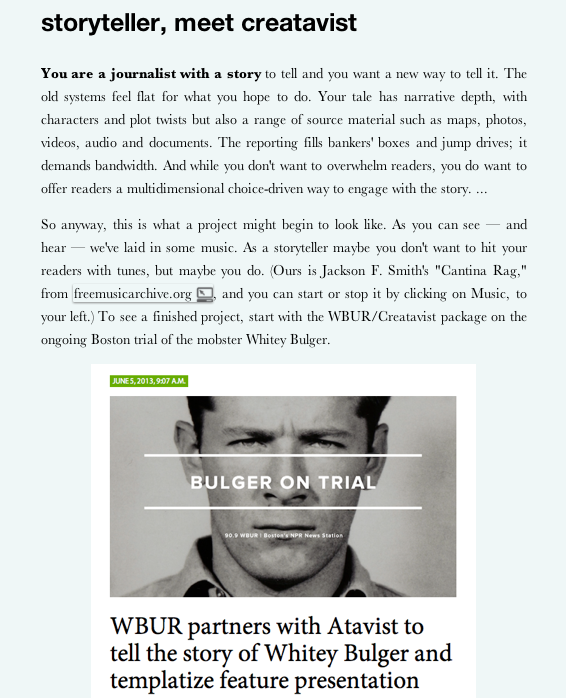You are a journalist with a story to tell and you want a new way to tell it. The old systems feel flat for what you hope to do. Your tale has narrative depth, with characters and plot twists but also a range of source material such as maps, photos, videos, audio and documents. The reporting fills bankers’ boxes and jump drives; it demands bandwidth. And while you don’t want to overwhelm readers, you do want to offer them a multidimensional story experience.
If you’re a freelancer, you might bypass the traditional publishers and crowdfund the story for your own WordPress site, or try to sell it through Amazon, or pitch it to an outlet like Byliner or Medium or Matter. But no, you’d rather be your own gatekeeper, and keep most of the cut. You want to handle your own design, hire your own fact checkers (which is more than some publishers bother to do). You want some operational transparency — exactly how much work are you selling, and how, and to whom?

A promising comes along: Creatavist, the newly launched storytelling platform from The Atavist, which started in 2009 as a publisher of original longform narrative for iPad. You discover that you can use Creatavist to self-publish a range of digital projects: single stories, books and magazines, how-to manuals, maps, archival projects, novels, short story collections, whatever. The work needn’t fall within any preconceived notions of story — it doesn’t have to be a gnarled, decades-long narrative; it can be a short, illustrated one, or a vivid photo essay, or a video project, or a how-to, or, beyond journalism, a poetry collection, a graphic novel, a comic. Through Creatavist, you can build and brand your own app, as did the Paris Review and TED Books. At the UC-Berkeley Graduate School of Journalism, a class of students exploring the intersection of food and health used it to launch an iOS magazine featuring their best longform work. The Knight Foundation thought enough of the platform to help fund it, writing:
Knight invested in (The) Atavist, the company (that) built Creatavist, last year through the Knight Enterprise Fund, with the hope that the company would be able to dramatically lower the cost of multimedia storytelling for journalists, particularly smaller newsrooms.
Founded in 2009 by a group of seasoned writers, including Evan Ratliff, Jefferson Rabb and Nicholas Thompson, Atavist was initially a stand-alone magazine made for tablets. The company’s business quickly evolved— to give others the chance to license the software used to publish the Atavist magazine. …
WBUR, however, is among the first to use the newly launched Creatavist, a freemium product, that gives journalists the ability to create stories on the web, and easily publish them to e-books and apps.
WBUR is, of course, the Boston NPR station that is using Creatavist for its Whitey Bulger trial coverage. The newsroom had this “incredible trove” of source material, decades worth, says Ratliff, an Atavist founder. “The challenge is figuring out to display those in the way that actually conveys as a story rather than just a collection of parts. That’s our goal in life.”
Other storytelling projects are in play, both editorial and commercial. The novelist Daniel Dalton beta-tested Creatavist and blogged:
It’s an opportunity to tell a richer story, to enhance the experience of the reader.
Imagine a character in your story finds a map. With Creatavist you can easily upload an image of that map, and then embed it on the word ‘map’. Users can then choose to click the word to see it for themselves.
Or let’s say a character is discussing a real world event. Perhaps a news story. Why not embed a video of the news report to let your reader learn more about it, to give those unfamiliar with the story the chance to catch up.
You could commission a soundtrack to play in the background, or just drunkenly sob into the microphone so the reader knows exactly how miserable/drunk you were when you wrote it. Yay art!
I used the enhanced features to add an audio file to each chapter, so you can choose to listen to me read the story in my Northern English accent if you wish (I’m no Neil Gaiman, but by all accounts I did a serviceable job).

So that sounds pretty cool. Let’s talk about the money, you say. Ratliff outlines the options: A storyteller can produce the first piece for free; $10 per month buys unlimited storytelling, plus the bandwidth for video; $250 per month allows you to make your own personal app and brand it. That’s coming on line next month.
And the ideal user? Anybody in mind?
“The ideal user is sort of in the vein of what The Atavist was at the beginning: a small group of people getting together to launch something, and to do something independent,” he says. “And it’s not necessarily a journalist with a story they can’t place but rather people saying, ‘I don’t need an outlet; I’ll make my own outlet; I have something I can find an audience for, and even sell to that audience.’ ”
So how would I sell my story to an audience? you ask.
“It’s not all set yet, but basically you’d be able to check a box that you want to sell your story/book, and then set a price. It’d be for sale in the app and on the website, and we’d take some cut of that sale. We haven’t set those percentage cuts yet; we’re still playing around with some numbers. But one thing we know for sure is that if you move from a free account to a $10/month account, we’ll take less of a cut. In other words, you’ll be buying your way up to a better percentage.”
What do you hope storytellers will do with Creatavist?
“We’re really interested in the form of the book and the form of the magazine and how those things are evolving. It’s hard at this point because you can’t sell anything, but I’d be interested in people trying different types of books and thinking about what constitutes a book. Because all of those things are breaking down online in interesting ways.”
What do you mean “what constitutes a book?”
“I don’t want this to imply that there’s no future for the book, but in the digital world you’re talking about — like the things we do: For instance, maybe it’s four two-minute videos and 5,000 words interspersed, in chapters. If you come from the book world you might call that an ‘enhanced book.’ But it’s not that. It’s something different. I think people are just thinking, ‘I have a story to tell. How do I tell that story?’ We don’t want the answer constrained by the fact that they’re thinking about it like a quote-unquote book.”
It’ll be interesting to see where this leads.
Yeah, he says. “The most optimistic thing to look at is something like Kickstarter. I remember when it started: A couple of things got funded but people thought of it as a sort of charity thing, like ‘Am I really gonna give money for these projects?’ I mean maybe those guys thought they’d be funding full-length feature films but I doubt it. They started with underfunding, but now it’s the place to go to fund creative projects outside the world of big publishing and big film. Ideally this falls into the same realm.”
You go to Creatavist and play around. It’s easy, and clean, and best of all, it’s yours:




